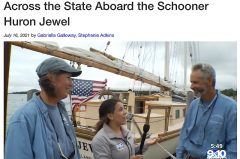May 26, 2016
The weather has warmed enough so that I’ve been able to get some gluing done. Epoxy will cure at 40 degrees, but a special formula has to be used and if allowed to warm too much, it quickly becomes “5-minute” epoxy.
All the bulkheads are now made and glued up. In this design, they function both as building forms and ring frames, so there are cleats or ribs of hardwood attached around the edges of the plywood bulkhead to receive the planking fasteners. These are made of red elm and sassafras. The stringers and longitudinals are all made and ready to be permanently fastened. These will hold the bulkheads straight and true and reinforce the joints between the sides and bottom, and the sides and decks.
A keelson running aft from the stem at the bow is laid in place, with a slot in it for the centerboard trunk. This trunk is the next major piece to fabricate. It has to hold the large centerboard and hold it against fairly large prying forces, so it will have oak posts at either end and the sides will be fabric-covered marine density overlay (MDO) plywood laminated to 1 inch thick.
Also, the rest of the transom has to be glued up to its final 2 1/2 inch thickness. With all these pieces in place, the next step is fairing the whole assembly, making sure the curves all line up in a smooth way that follows the intended design.
Then, the big step, planking. The douglas fir for this is already on hand and should go quickly after the first pieces are on and fair. Then it will really start to look like a boat instead of a boat skeleton, albeit upside down.
With these sunny spring days the afternoon temperature in the shop has been reaching 75 degrees, which means the epoxy is happy but determined in its chemistry to become a high-strength solid.
– Captain Hugh







